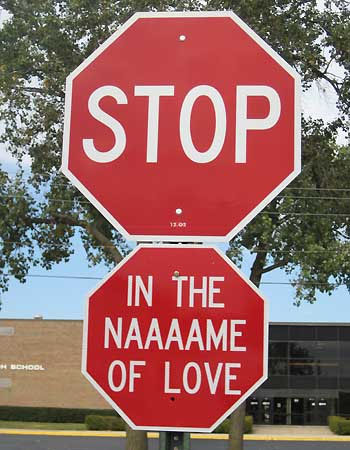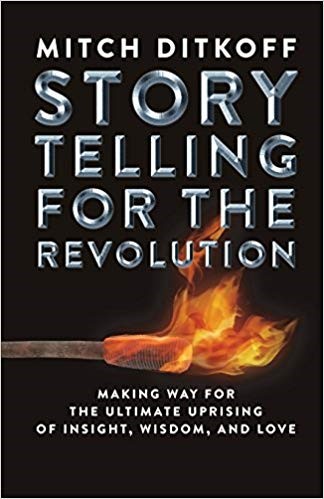The Curious Origins of the Stop Sign

I've been doing some fascinating research lately on the origins of common objects in our lives -- things we see daily, but often take for granted. Like the Stop Sign, for example.
Most people think the Stop Sign was created to regulate traffic. Not true. According to Dr. Ellison Burke of the Global Institute for Slowing Things Down Before You Hurt Yourself, the origin of the Stop Sign has nothing to do with traffic -- and dates back several thousand years.
Historical references to the Stop Sign have been noted in more than 27 civilizations, most notably Babylonia, Egypt, Mesopotamia, Sumeria, Crete, Rome, and the Han Dynasty.

According to social scientists, each of these civilizations experienced one or more periods of rapid growth now referred to in the literature as "Societal Acceleration Syndrome" -- the way in which daily transactions speed up in proportion to a civilization's escalating Gross National Product.
In other words, speed has become one of the most statistically predicable indicators of a civilization's development and, as I will note later in this article, eventual decline.
My research doesn't end here, however. In each of the above-mentioned civilizations, there have always been a small, but vocal group of citizens who -- concerned about the quickening pace of daily life -- have warned the masses about this dangerous phenomenon.
Indeed, a joint longitudinal study conducted by the Yukon Archeological Institute and the Asian Society for Shorter Haiku, has revealed that this "small, but highly committed group of socially responsible citizens" has made repeated efforts to diffuse their respective society's "escalating addiction to velocity."
In Sumeria, for example, a fringe group of philosophers and poets routinely posted "Styopsian" signs at strategic intersections throughout the country -- not to stop traffic, but to stop unnecessary "mind movement."
Their effort resonated with the citizenry and eventually led to the widespread appearance of what modern day sociologists now refer to as "stop signs" -- in urban centers, villages, cattle crossings, and universities.
One of the most curious facts I've unearthed in my research is this: For the past 2,000 years, Stop Signs, regardless of the country of origin, have always been octagonal.
Apparently, each side of this iconic 8-sided, cross-cultural symbol for stillness, has been imbued with a secret teaching of great import:

1. Slow down
2. Pay attention
3. Look around
4. Pause
5. Look within
6. Breathe deeply
7. Appreciate
8. Move consciously
And so... the next time you see a Stop Sign, you may want to remember that you, no matter where you think you're going or how quickly you need to get there are, in fact, in the act of receiving one of the most timeless of teachings -- one that preceded Facebook, Instagram, Snapchat, texting, and Donald Trump tweeting in the middle of the night.
Next week... the YIELD SIGN.
ED NOTE: It has recently come to my attention that some readers of this blog have questioned my research methods and the veracity of my findings. A quick Google search of "Dr. Ellison Burke" and the "Global Institute for Cross-Cultural Studies," they claim, reveals not a single link. Frankly, I am baffled by their assertions and have assigned five of my brightest research assistants to get to the bottom of the matter. In the meantime, as I put to rest the niggling, naysaying deflections of my detractors, you may want to contemplate the timeless words of modern-day social scientists, Simon and Garfunkel: "Slow down, you're moving too fast, you gotta make the morning last."
This story NOT included in this book
This story NOT included in this website
This story NOT included in this training
Stop Signs 'R Us
Comments
Dear Mitch:
CONGRATULATIONS and THANKS for your post.
Too bad you chose to go to Mexico....
Just in case, I will have a couple of bottles of nice Chilean wine (Red and white) waiting for your visit anyway....
Posted by: JJPEREZK ![[TypeKey Profile Page]](https://www.ideachampions.com/weblogs/nav-commenters.gif) at December 18, 2009 12:58 PM
at December 18, 2009 12:58 PM
Mitch - great post...looking forward to more 'signs' - am curious if you can discover (and i'll see what I can find) on why the signs are always octagonal --
thank you!
deb
Posted by: Dscofield ![[TypeKey Profile Page]](https://www.ideachampions.com/weblogs/nav-commenters.gif) at January 22, 2011 09:27 AM
at January 22, 2011 09:27 AM
Deb (and others): Despite my efforts to write a PARODY about the origins of the Stop Sign, there continue to be readers who believe my post. I guess I got to go back to parody school. Anyway, here is the REAL SCOOP on stop signs.
# The first stop sign appeared in Detroit, Mich., in 1915. Since then, the stop sign has undergone several changes. In 1922, a committee working under the American Association of State Highway Officials gave the stop sign its familiar octagonal shape.
# The first stop sign was made from white metal, with black lettering. In 1924, the background color was changed to yellow. In 1930, the National Conference on Street and Highway Safety published the "Manual on Street Control Signs, Signals, and Markings," (MSCSSK) which called for red letters on a yellow background. It wasn't until 1954 that the stop sign was given the familiar white lettering on red background that we know today.
# The MSCSSK states that stop signs be octagonal in shape, measure 30" x 30", and have a white border and lettering against a red background.
# Only stop signs are allowed to have an octagonal shape. The more sides on a sign, the greater the danger if disregarded.
# Regulations mandate that stop signs be mounted so to be visible for a minimum distance determined by the 85th percentile approach speed. They state also that the stop sign be mounted at a minimum height of 5 to 7 feet.
Posted by: Mitch Ditkoff ![[TypeKey Profile Page]](https://www.ideachampions.com/weblogs/nav-commenters.gif) at January 22, 2011 09:41 AM
at January 22, 2011 09:41 AM
"you've got to make the morning last now"....Mitch this is such a brilliant (and he larry us) post! I know that I will never look at a stop sign in the same way again. Or rather, I will look at stop signs now.....
Posted by: Lynn Kindler ![[TypeKey Profile Page]](https://www.ideachampions.com/weblogs/nav-commenters.gif) at October 20, 2011 09:43 PM
at October 20, 2011 09:43 PM
This blog was one of the more interesting one that I have read in a long time. I thought the Dr. for the Global Institute for Slowing Things Down Before You Hurt Yourself Badly was very funny being that you really had me going which made it even more entertaining. In addition I believe that people tend to be so wrapped up in there own day to day lives that mankind as a whole we do not stop and wonder why the things that are around us, are the way they are. Through this parody I believe that my eyes have been opened again to questioning the origins of the little things in my own life that I tend to just always knew they were there but never thought how whoever created them even thought to create them. Lastly the readers that tend to question the blog are looking more into them, your blog have be in ways insightful, entertaining, and lastly a expression of your own thoughts that you were bold enough to put out there for others to see keep it up!
Posted by: BFoster#9 ![[TypeKey Profile Page]](https://www.ideachampions.com/weblogs/nav-commenters.gif) at November 15, 2012 12:56 PM
at November 15, 2012 12:56 PM
Post a comment
Thanks for signing in, . Now you can comment. (sign out)
(If you haven't left a comment here before, you may need to be approved by the site owner before your comment will appear. Until then, it won't appear on the entry. Thanks for waiting.)














